See also Detecting Clash in Parts Placement and Placing Parts Using a Schematic.
If the Function Driven flag in the project resource management file is set to 2, then only functionless parts placement will be possible in Equipment Arrangement.
When you place an object using this command, a unique reference will be created and placed in the CATTemp directory. The instance will not point to the catalog. If you want the instance to point to the catalog reference then you need to add a keyword to the family to which the part belongs. Add the following to the family, using the Catalog Editor:
- Name - LoadType;
- Type - String;
- Default Value - SameReference.
To learn how to add a keyword see Creating a Catalog in the Component Catalog Editor user guide.
1.
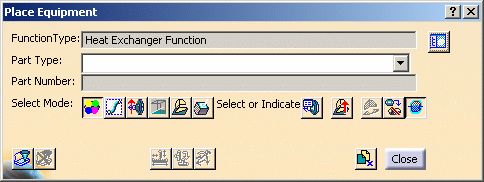
- Select or Indicate: This is the default selection and allows you to select or indicate a placement location.
- Select Run Only: You can only select a run.
- Select Connector Only: Allows you to select a part connector only. First select a part - all connectors display - then select the connector.
- Indicate On Local XY Plane: You can select a location that is on the XY plane of the local axis of the document.
- Indicate on Compass Plane: You can select a location that is on the compass plane. If the compass is inactive then the local plane will be used.
- Select Surface: Select a surface and then select a location.
- Select part to display connector list: This button allows you to use a dialog box to select the connector on which to place a part, and is useful in busy documents. Click this button if you want to select the connector on which to place your part by using a dialog box, instead of selecting the connector in the viewer. With your document open, select the part you want to place, click the Select part to display connector list button and choose the part on which you want to place your part. A Selected Part dialog box will display, showing all the connectors on your selected part. The selected connector will be highlighted, and will be orange in the viewer. Select the connector on which you want to place your part and click OK.
- Use Compass Z for Placement Up Orientation: The part will align itself with the compass Z direction, and not the default 'up' direction of the part. In the image below the valve on the left shows the default up direction, the valve on the right aligns to the compass Z direction.
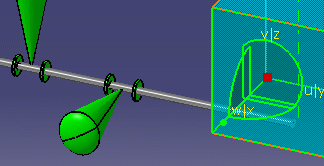
- Place at the Current Compass: This allows you to place the part at the compass location. The button is available only after you have moved the compass. To use, select your part, move the compass to the location where you want to place the part, and click the Place at Current Compass button. The part will place at that location.
- Replace an Existing Part: You can use this button to replace a part in your document with another part. To use, select the part you want to place, click the Replace an Existing Part button, and click the part you want to replace. Click OK in the Replace Part dialog box when it displays. The part will be replaced.
- Ignore Compatibility Check with Neighbors: When you click this button you can place bendables and stretchables without invoking compatibility rules. NOTE: This button changes a Tools > Options setting (under Equipment & Systems > Design Criteria). However, this function depends upon a project resource management entry "Ignore Neighbor Compatibility", which takes precedence. Certain options (e.g. Options 0 & 1) you define for this resource in the PRM file will result in the button being grayed out.
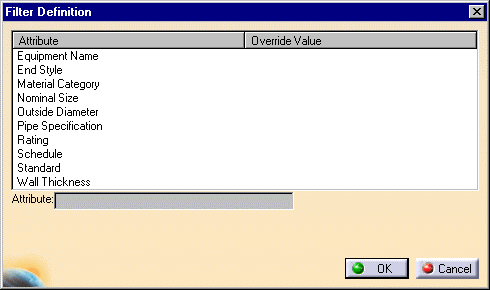
- The Override button brings up the Manage Override Parameters dialog box, allowing you to change attribute values.
- The Flip Part button allows you to flip parts that can be flipped, such as a reducer.
- The Move/Rotate button displays the Move/Rotate dialog box, allowing you to manipulate the part.
- The Change to Schematic Mode button lets you toggle between schematic and non-schematic mode. You will exit the command when you click this button and need to click the Place Part command again.
- The Close button exits you from the command.
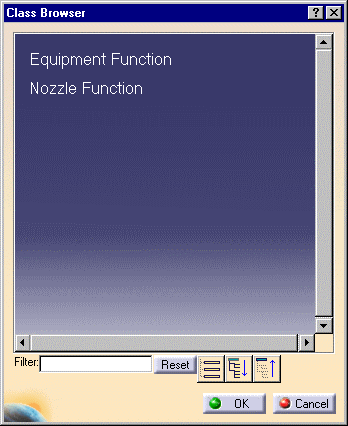
Note: You can choose to display the class browser expanded, or collapsed, as shown above, by using a setting. To display it expanded, go to Tools - Options - Equipment & Systems, click the Design Criteria tab, and check the option Expand Class Browser. Uncheck it to display it collapsed.
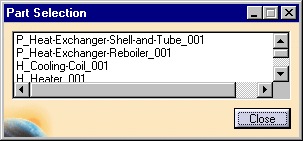
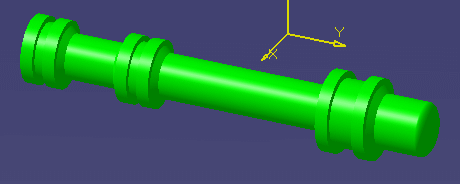
By default, when you click (in free space) to place a part the center of that part will be placed at that location. The center is determined by the application by drawing a box around the part and selecting the center of the base of the box. You can also choose to place the origin of the part at the point where you click. To do this click on Tools - Options and select Equipment & Systems and the General tab. Check the box Place at component's origin when placing in free space.
After you move or modify a part,
click the
Update
Part button
![]() and select a part to
update that part. You only need to do this if the application does not
update the object.
and select a part to
update that part. You only need to do this if the application does not
update the object.